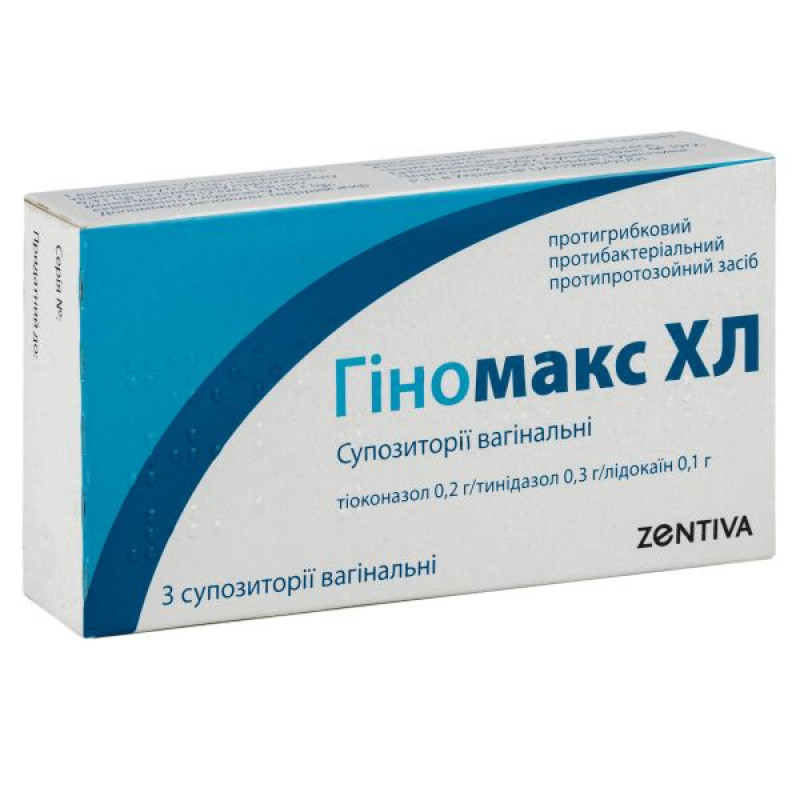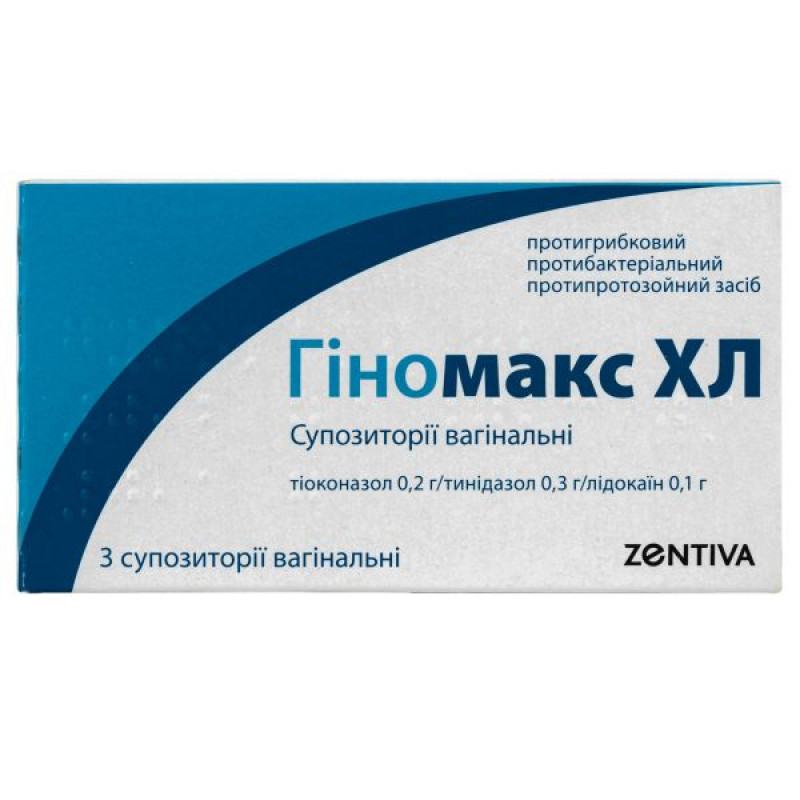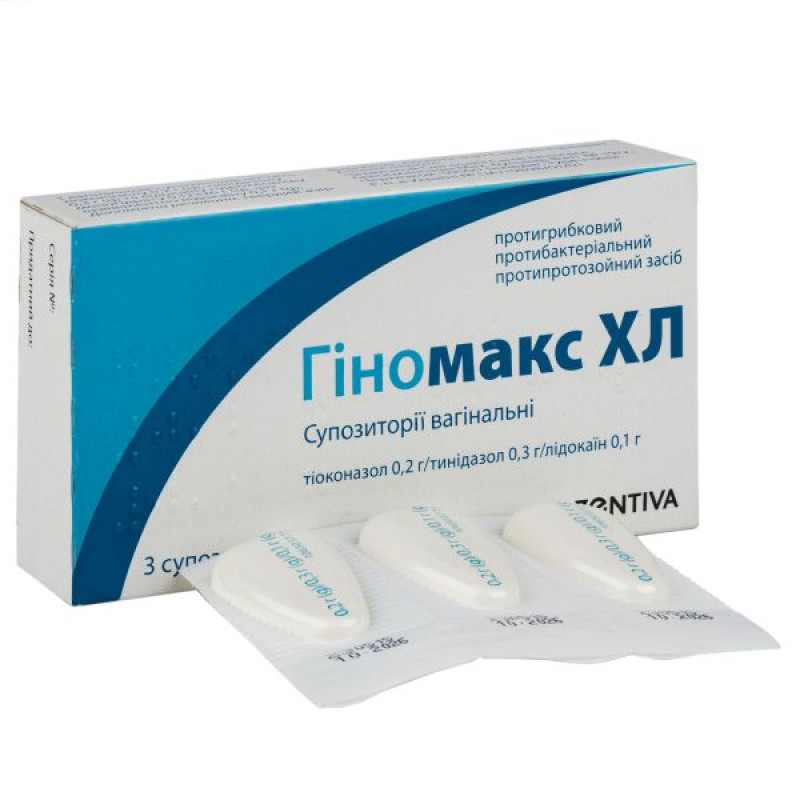Gynomax HL vaginal suppositories 0.2 g/0.3 g/0.1 g No. 3

Instructions for use Gynomax HL vaginal suppositories 0.2 g/0.3 g/0.1 g No. 3
Composition
active ingredients: tioconazole, tinidazole and lidocaine hydrochloride monohydrate;
1 vaginal suppository contains tioconazole 0.2 g, tinidazole 0.3 g and lidocaine hydrochloride monohydrate 0.12326 g, which is equivalent to lidocaine 0.1 g;
excipient: solid fat.
Dosage form
Vaginal suppositories.
Main physicochemical properties: flat suppository from white to yellowish in color, with a smooth surface.
Pharmacotherapeutic group
Antimicrobial and antiseptic agents used in gynecology, except combinations with corticosteroids. Combination of imidazole derivatives. ATX code G01A F20.
Pharmacological properties
Pharmacodynamics
Tioconazole is a synthetic antifungal agent with high in vitro activity against yeast-like and other fungi (including dermatophytes). It is also effective against Trichomonas vaginalis, Gardnerella vaginalis, bacteria of the Bacteroides family, and some Gram-positive bacteria (including bacteria of the Staphylococcus and Streptococcus families). In clinical studies, tioconazole has been shown to be effective in the treatment of diseases caused by Candida Albicans and other Candida species (Torulopsis glabrata), and vaginal infections caused by Trichomonas vaginalis.
Tioconazole acts by altering the permeability of the fungal cell membrane. Ergosterol is an important component of the fungal cell membrane. Tioconazole inhibits ergosterol synthesis by interacting with 14α-demetalase, a cytochrome P450 enzyme that converts lanosterol to ergosterol. Inhibition of ergosterol synthesis leads to increased cell permeability and, consequently, to leakage of intracellular phosphorus and potassium compounds through the cell membrane.
Tinidazole is effective against most protozoa and anaerobic bacteria. Its antiprotozoal effect extends to Trichomonas vaginalis, Entamoeba histolytica and Giardia lamblia. Tinidazole is effective against Gardnerella vaginalis and most anaerobic bacteria (Bacteroides fragilis, Bacteroides melaninogenicus, bacteria of the Bacteroides family, bacteria of the Clostridium family, bacteria of the Eubacterium family, Peptostreptococcus and Veillonella).
The full mechanism of action of tinidazole is not fully understood. Reduction of the nitro group occurs via the ferredoxin system and due to the low redox potential, which is created only by anaerobic bacteria. This may be the reason why the absorption of tinidazole is more active in anaerobes than in aerobes, although tinidazole penetrates the cell membranes of both types of microorganisms.
The reduction process creates an increased diffusion gradient that enhances the uptake of tinidazole and reactive intermediates.
Lidocaine is a local anesthetic of the amide series. It stabilizes neuronal membranes by inhibiting the ion currents necessary for the initiation and conduction of impulses, thereby providing a local anesthetic effect.
Pharmacokinetics
Absorption
Tinidazole
The absorption of tinidazole after intravaginal administration is approximately 10%.
The mean peak plasma concentration was 1.0 μg/ml; in 6 healthy volunteers, the time to reach this level (tmax) was 8.7 hours after administration of a vaginal suppository containing 500 mg tinidazole.
Tioconazole
When administered intravaginally, tioconazole is absorbed in low concentrations by the mucosa. The mean peak plasma concentration after administration of a single dose of 300 mg tioconazole ointment to women with candidal vulvovaginitis was 18 μg/mL.
Lidocaine
Lidocaine is absorbed in small amounts through damaged skin and mucous membranes.
Distribution
Tinidazole
Tinidazole is almost completely distributed in all tissues and body fluids, and also penetrates the blood-brain barrier. The known volume of distribution is about 50 liters. Plasma protein binding is approximately 12%. Tinidazole penetrates the placental barrier and into breast milk.
Tioconazole
In most clinical studies, after intravaginal administration of a single dose of 300 mg tioconazole, it was determined that its concentrations in vaginal fluid provide inhibition of the growth of Candida albicans for 2–3 days.
It is not known whether tioconazole passes into breast milk.
Lidocaine
Plasma protein binding is 60–80%. Lidocaine crosses the placenta and blood-brain barrier by passive diffusion and is distributed in cerebrospinal fluid, highly perfused tissues (kidneys, liver, heart) and adipose tissue. The volume of distribution is 0.8–1.3 l/kg.
Biotransformation
Tinidazole
Tinidazole is partially metabolized by oxidation, hydroxylation, and conjugation.
Tinidazole is biotransformed mainly by cytochrome CYP3A4.
Tioconazole
The main metabolite of tioconazole is the glucuronide conjugate.
Tioconazole is not metabolized in vaginal fluid, but the portion of the drug that is absorbed systemically after intravaginal administration is metabolized. One reported metabolite is formed by N-glucuronidation of the nitrogen on the imidazole ring, the other is formed by O-dethienylation of the chlorothienyl group, hydration in alcohol, and glucuronidation.
Lidocaine
Lidocaine is metabolized in the liver. Its active metabolites are monoethylglycine hexylidide and glycine hexylidide.
Breeding
The plasma half-life of tinidazole is approximately 12–14 hours. Tinidazole is eliminated via the liver and kidneys. Tinidazole is mainly excreted unchanged in the urine (approximately 20–25% of the administered dose). Approximately 12% of the drug is excreted in the feces.
Tioconazole
After intravaginal administration of tioconazole, the drug is eliminated from plasma, usually within 72 hours.
After oral administration of tioconazole, 25–27% of the dose is excreted in the urine as metabolites, and 59% of the dose is excreted in the feces (mainly unchanged).
Lidocaine
After intravenous administration, 90% of the absorbed dose is excreted as metabolites, and less than 10% is excreted unchanged in the urine.
Linear/non-linear nature
Data is missing.
Indication
For the treatment of candidal vulvovaginitis caused by pathogens of the Candida albicans family, bacterial vaginosis caused by pathogens of the Gardnerella vaginalis family and anaerobic bacteria, trichomonas vaginitis caused by Trichomonas vaginalis, as well as vaginitis caused by mixed infection.
Contraindication
- Hypersensitivity to the active ingredients or their derivatives.
- Drinking alcoholic beverages during treatment and for 3 days after treatment.
- Taking disulfiram during treatment and for 2 weeks after treatment.
- Porphyria.
- Epilepsy.
- Severe liver dysfunction.
- First trimester of pregnancy.
- Breastfeeding period.
- Organic diseases of the nervous system.
- Violations of hematopoiesis, including a history.
Interaction with other medicinal products and other types of interactions
Due to the absorption of tinidazole, the following interactions with other drugs are observed.
Acenocoumarol, anisindione, dicumarol, phenindione, phenprocoumon, warfarin: increased risk of bleeding.
Cholestyramine: reduced effectiveness of tinidazole.
Cimetidine: increased concentration of tinidazole in blood plasma.
Cyclosporine: increased cyclosporine levels.
Disulfiram: central nervous system side effects (e.g. psychotic reactions).
Fluorouracil: increased blood levels of fluorouracil and signs of possible intoxication (granulocytopenia, anemia, thrombocytopenia, stomatitis, vomiting). Fosphenytoin: increased toxicity of fosphenytoin and/or decreased blood levels of tinidazole.
Ketoconazole: increased plasma concentrations of tinidazole.
Lithium preparations: increased lithium concentration in the blood and signs of lithium intoxication (weakness, tremor, polydipsia, confusion).
Phenobarbital: decreased blood concentration of tinidazole.
Phenytoin: increased risk of phenytoin intoxication and/or decreased blood concentrations of tinidazole.
Rifampin: decreased blood concentrations of tinidazole.
Tacrolimus: increased tacrolimus levels.
CYP3A4 inducers/inhibitors: reduced efficacy of tinidazole or increased risk of adverse reactions (CYP3A4 inhibitors such as cimetidine and ketoconazole may prolong the half-life, as well as reduce the blood clearance of tinidazole and increase the plasma concentration of tinidazole).
Due to the absorption of tioconazole, the following interactions with other drugs are observed.
Oxycodone: Concomitant administration of tinidazole and oxycodone may increase the plasma concentration of oxycodone and reduce the clearance of this substance.
Due to the absorption of lidocaine, the following interactions with other drugs are observed.
Propranolol: decreased plasma clearance of lidocaine.
Cimetidine: decreased plasma clearance of lidocaine.
Antiarrhythmics: increased toxicity of lidocaine.
Phenytoin or barbiturates: decreased plasma concentrations of lidocaine.
Additional information regarding special patient groups
Interaction studies involving special patient groups have not been conducted.
Application features
For intravaginal use only. Do not swallow or insert into other areas.
Like other drugs with a similar structure, tinidazole should not be used in patients with impaired hematopoiesis, including a history of it. Transient leukopenia and neutropenia may develop. No persistent hematological abnormalities were observed in preclinical and clinical studies.
Patients should refrain from drinking alcohol during treatment and for at least 3 days after the end of treatment due to the increased risk of disulfiram-like reactions.
Should not be used in virgin girls.
The drug should be used with caution in patients with cardiovascular disorders.
Suppositories should not be used with contraceptives such as diaphragms and condoms, as the suppository may interact with the rubber in an undesirable way.
Lidocaine can cause heart rhythm disturbances, difficulty breathing, coma, and even death if applied to large areas of skin and under occlusion.
Other intravaginal products (e.g. tampons, douches or spermicides) should not be used simultaneously with GYNOMAX XL.
When treating patients with trichomonas vaginitis, simultaneous treatment of the sexual partner is necessary.
Use during pregnancy or breastfeeding
Since the effects of the active ingredients of GYNOMAX XL on the fetus and newborn are unknown, women who are to use this drug should avoid pregnancy by using effective methods of contraception.
Pregnancy
Tinidazole crosses the placental barrier.
Animal studies are insufficient to assess the effects of the drug on pregnancy, embryonic/intrauterine development, parturition, and postnatal development. The potential risk to humans is unknown.
There is insufficient data on the use of GYNOMAX XL in the first trimester of pregnancy. Therefore, the drug is contraindicated in the first trimester of pregnancy. The possibility of prescribing the drug during the second and third trimesters should be assessed by a doctor, taking into account the benefit/risk ratio. The drug should not be used during pregnancy unless clearly necessary.
Breastfeeding period
Breastfeeding should be discontinued during treatment, as the active ingredients of GYNOMAX XL penetrate into breast milk. Breastfeeding can be resumed 72 hours after the end of treatment.
Reproductive function/fertility
In a 60-day reproductive toxicity study, tinidazole at a dose of 600 mg/kg/day reduced fertility and promoted the development of histopathological changes in the testes of male animals. Doses of 300 and 600 mg/kg/day caused spermatogenic effects. The maximum dose of the drug that did not lead to the development of observable undesirable effects in the testes and sperm was 100 mg/kg/day. These effects are characteristic of the 5-nitroimidazole class of drugs.
No effect on fertility was observed in male animals when tioconazole was administered orally at doses up to 150 mg/kg/day. However, there is evidence of preimplantation loss in female rats at oral doses above 35 mg/kg/day.
There is no evidence of harmful effects of lidocaine on animal or human fertility.
Ability to influence reaction speed when driving vehicles or other mechanisms
It is not known whether GYNOMAX XL affects the ability to drive and use other mechanisms.
Method of administration and doses
Do not use without a doctor's prescription. Unless otherwise prescribed by a doctor, insert 1 suppository deep into the vagina at night for 3 days.
Should not be used twice a day without prescription.
The use of the drug GYNOMAX XL during menstruation is not recommended due to a decrease in its effectiveness and difficulties in use.
For intravaginal use only. GYNOMAX XL should be inserted deep into the vagina in the supine position.
Do not swallow or inject into other areas.
Additional information regarding special patient groups
Renal/liver impairment
No significant changes in pharmacokinetic parameters (CrCL) were observed in patients with severe renal impairment.
Tinidazole clearance is significantly increased during hemodialysis, and the half-life is reduced from 12 hours to 4.9 hours. 43% of the available tinidazole was removed during a 6-hour dialysis session. If tinidazole is to be administered prior to hemodialysis, it is recommended that half the recommended dose of tinidazole be administered after hemodialysis.
There are no data on the pharmacokinetics of tinidazole in patients with hepatic impairment. The recommended dose of tinidazole should be administered with caution to patients with hepatic impairment.
In patients with hepatic insufficiency, the half-life of lidocaine may be prolonged by twofold or more. Renal insufficiency does not affect the pharmacokinetics of lidocaine, but it may increase the accumulation of metabolites. Patients with hepatic and/or renal insufficiency who will take GYNOMAX XL should take these characteristics into account.
Elderly patients
Patients over 65 years of age are prescribed the same dose as adults.
Children.
Do not use on children.
Overdose
Systemic side effects may occur with accidental ingestion of large amounts of the drug, but life-threatening symptoms are not expected with intravaginal use.
There is no specific antidote for tinidazole. In case of overdose, symptomatic and supportive therapy should be initiated. Gastric lavage may be considered. Side/adverse effects of overdose are unknown.
With topical application, an overdose of tioconazole is unlikely due to its low systemic absorption.
With the topical application of high doses of lidocaine, heart rhythm disturbances, difficulty breathing, coma and even death are possible.
Adverse reactions
The frequency of the following undesirable effects is determined according to the following classification:
very common (≥ 1/10); common (≥ 1/100 to
GYNOMAX XL is well tolerated at the site of application.
Adverse reactions typical of systemic use of the active ingredients of GYNOMAX XL are listed below, although they have not been reported with vaginal use. Since blood concentrations of tinidazole are much lower with intravaginal use, the effects are expected to be smaller.
Blood and lymphatic system disorders
Frequency unknown: leukopenia (transient), neutropenia (transient).
On the part of the immune system
Frequency unknown: allergic reactions (in particularly severe cases, anaphylactic shock is possible).
Common: weakness, fatigue, malaise, headache, dizziness.
Frequency unknown: ataxia, coma (rare), confusion (rare), depression (rare), loss of sensitivity, inhibition, insomnia, sleep disorders, anxiety, psychosis, fainting, speech disorders, feeling of fear, vertigo, peripheral neuropathy, convulsions, overexcitation, disorientation, euphoria, hallucinations, hyperesthesia, hypoesthesia, lethargy.
Cardiovascular system
Frequency unknown: arrhythmia, bradycardia, arterial spasm, cardiovascular collapse, increased defibrillator threshold, edema, hyperemia, heart block, hypotension, sinus node depression.
From the digestive tract
Common: metallic/bitter taste in the mouth, nausea, anorexia, loss of appetite, flatulence, dyspepsia, abdominal cramps, epigastric discomfort, vomiting, constipation.
Frequency unknown: stomach pain, diarrhea, coated tongue, stomatitis, tongue discoloration, dry mouth, pseudomembranous colitis.
Skin and subcutaneous tissue disorders
Frequency unknown: itching, urticaria, angioedema, skin rash.
From the urinary system
Common: dark urine.
General disorders and administration site conditions
Frequency unknown: burning at the injection site, dysuria, local swelling and irritation, itching, vaginal discharge, dyspareunia, nocturia, vaginal pain.
Reporting of suspected adverse reactions
Once a medicine has been authorised, it is very important to report suspected adverse reactions. This allows for continuous monitoring of the benefit-risk balance of the medicine. Healthcare professionals should report any adverse reactions via the national reporting system.
In the event of undesirable manifestations, adverse reactions or in the absence of therapeutic effect, it is necessary to report to the address ZENTIVA UKRAINE LLC, 02002, Kyiv, Brovarskyi Avenue, 5 "I", tel./fax: +38 044 517-75-00, e-mail address PV-Ukraine@zentiva.com.
Expiration date
3 years.
Storage conditions
Store at a temperature not exceeding 25 °C.
Keep out of reach of children.
Packaging
3 vaginal suppositories in a strip; 1 strip in a cardboard pack.
Vacation category
According to the recipe.
Producer
EXCELTIS ILACH SANAYI VE TIJARET ANONIM SHIRKETI
Location of the manufacturer and its business address.
Çerkezkoy Organiz Sanayi Belgese, Gaziosmanpaşa Mah. Fati Boulevard No. 19/2, Çerkezkoy, 59500 Tekirdag, Turkey.
There are no reviews for this product.
There are no reviews for this product, be the first to leave your review.
No questions about this product, be the first and ask your question.








